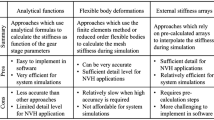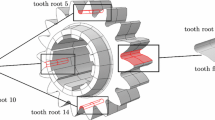Abstract
Gear drives are crucial components for a wide range of devices such as combustion engines and wind turbines. Predictions of durability, transmission errors, and noise emission are required already during early development. To that end, deformations, velocities, stresses, and contact forces can be analyzed using numerical simulations. For this, finite element analyses (FEA) or multibody system (MBS) simulations can be used. Yet, rigid MBS can be inaccurate since contact forces must be estimated using a heuristic force–displacement law since no deformations are available. Also, the need for elaborate manual tuning of contact parameters is a drawback. FEA, on the other hand, bring about long computation times that make them inappropriate for the analysis of transient phenomena. Further, a bottleneck of FEA for gears is the expensive human labor that is necessary to generate hexahedral meshes required for contact detection. Both quadratically and linearly interpolating tetrahedral meshes can be generated quickly and reliably. Tet4 elements, however, are not a viable option due to their inferior performance. Thus, as a remedy to (i) the parametrization issues and the inaccuracy inherent while using rigid MBS descriptions, (ii) the long simulation times of FEA, and (iii) the issue of expensive manual generation of hexahedral meshes, we propose using elastic multibody systems with quadratic tetrahedral meshes for dynamic contact simulations. The novelty of this contribution is the use of quadratic ansatz functions for the description of both geometry and contact calculation in combination with a floating frame of reference formulation and model order reduction.











Similar content being viewed by others
References
Musial, W.D., Butterfield, S., Charles, P., McNiff, B.P.: Improving wind turbine gearbox reliability. Technical report, US National Renewable Energy Laboratory, Golden (2007)
Harris, S.L.: Dynamic loads on the teeth of spur gears. Proc. Inst. Mech. Eng. 172(1), 87–112 (1958)
Kahraman, A.: Load sharing characteristics of planetary transmissions. Mech. Mach. Theory 29(8), 1151–1165 (1994)
Pfeiffer, F., Prestl, W.: Hammering in Diesel-engine driveline systems. Nonlinear Dyn. 5(4), 477–492 (1994)
Prestl: Zahnhämmern in Rädertrieben von Dieselmotoren (in German). VDI Fortschritt-Berichte, Reihe 20, Nr. 227. VDI Verlag, Düsseldorf (1991)
Eritenel, T., Parker, R.G.: An investigation of tooth mesh nonlinearity and partial contact loss in gear pairs using a lumped-parameter model. Mech. Mach. Theory 56, 28–51 (2012)
Hippmann, G.: An algorithm for compliant contact between complexly shaped bodies. Multibody Syst. Dyn. 12(4), 345–362 (2004)
Velex, P., Maatar, M.: A mathematical model for analyzing the influence of shape deviations and mounting errors on gear dynamic behaviour. J. Sound Vib. 191(5), 629–660 (1996)
Ziegler, P.: Dynamische Simulation von Zahnradkontakten mit elastischen Modellen (in German). Dissertation, Schriften aus dem Institut für Technische und Numerische Mechanik der Universität Stuttgart, Vol. 23. Shaker Verlag, Aachen (2012)
Do, T.P., Ziegler, P., Eberhard, P.: Review on contact simulation of beveloid and cycloid gears and application of a modern approach to treat deformations. Math. Comput. Model. Dyn. Syst. 21(4), 359–388 (2015)
Helsen, J., Marrant, B., Vanhollebeke, F., Coninck, F.D., Berckmans, D., Vandepitte, D., Desmet, W.: Assessment of excitation mechanisms and structural flexibility influence in excitation propagation in multi-megawatt wind turbine gearboxes: experiments and flexible multibody model optimization. Mech. Syst. Signal Process. 40(1), 114–135 (2013)
Schurr, D., Holzwarth, P., Eberhard, P.: Investigation of dynamic stress recovery in elastic gear simulations using different reduction techniques. J. Comput. Mech. 62(3), 439–456 (2018)
Benzley, S.E., Perry, E., Merkley, K., Clark, B., Sjaardama, G.: A comparison of all hexagonal and all tetrahedral finite element meshes for elastic and elasto-plastic analysis. In: Proceedings of the 4th International Meshing Roundtable, Vol. 17, pp. 179–191 (1995)
Braess, D.: Finite Elements: Theory, Fast Solvers, and Applications in Elasticity Theory, 3rd edn. Cambridge University Press, Cambridge (2007)
Hughes, T.J.R.: The Finite Element Method: Linear Static and Dynamic Finite Element Analysis. Dover Publications, New York (2000)
Boffi, D.: Finite element approximation of eigenvalue problems. Acta Numerica 19, 1–120 (2010)
Tobias, C., Eberhard, P.: Stress recovery with Krylov-subspaces in reduced Elastic Multibody Systems. Multibody Syst. Dyn. 25(4), 377–393 (2011)
Tamarozzi, T., Ziegler, P., Eberhard, P., Desmet, W.: Static modes switching in gear contact simulation. Mech. Mach. Theory 63, 89–106 (2013)
Schurr, D.: Dynamische vollelastische Simulation von Planetengetrieben auf Basis von EMKS und nodalem Kontakt (in German). Dissertation, Schriften aus dem Institut für Technische und Numerische Mechanik der Universität Stuttgart, Vol. 55. Shaker Verlag, Aachen (2018)
Bathe, K.-J.: Finite Element Procedures. Prentice-Hall, Upper Saddle River (1996)
Schwertassek, R., Wallrapp, O.: Dynamik flexibler Mehrkörpersysteme (in German). Vieweg, Braunschweig (1999)
Shabana, A.A.: Dynamics of Multibody Systems. Cambridge University Press, New York (2005)
Kikuchi, N., Oden, J.T.: Contact Problems in Elasticity: a Study of Variational Inequalities and Finite Element Methods. Studies in Applied Mathematics. Society for Industrial and Applied Mathematics, Philadelphia (1988)
Vigué, P., Vergez, C., Karkar, S., Cochelin, B.: Regularized friction and continuation: comparison with Coulomb’s law. J. Sound Vib. 389, 350–363 (2017)
Shewchuk, J.R.: Tetrahedral mesh generation by Delaunay refinement. In: Proceedings of the 14th Annual ACM Symposium on Computational Geometry, pp. 86–95 (1998)
Shewchuk, J.R.: Constrained Delaunay tetrahedralizations and provably good boundary recovery. In: Proceedings of the 11th International Meshing Roundtable, pp. 193–204 (2002)
Li, Y., Liu, Y., Xu, W., Wang, W., Guo, B.: All-hex meshing using singularity-restricted field. ACM Trans. Graph. 31(6), article no. 177 (2012)
Liu, H., Zhang, P., Chien, E., Solomon, J., Bommes, D.: Singularity-constrained octahedral fields for hexahedral meshing. ACM Trans. Graph. 37(4), article no. 93 (2018)
Hilber, H., Hughes, T., Taylor, R.: Improved numerical dissipation for time integration algorithms in structural dynamics. Earthq. Eng. Struct. Dyn. 5, 283–292 (1977)
Dassault Systèmes: Abaqus Theory Guide. Dassault Systèmes Simulia Corp., Providence (2014)
Dassault Systèmes: Abaqus/CAE User’s Guide. Dassault Systèmes Simulia Corp., Providence (2014)
Dormand, J.R., Prince, P.J.: A family of embedded Runge–Kutta formulae. J. Comput. Appl. Math. 6(1), 19–26 (1980)
Shampine, L.F., Reichelt, M.W.: The matlab ode suite. SIAM J. Sci. Comput. 18(1), 1–22 (1997)
Dietz, S.: Vibration and fatigue analysis of vehicle systems using component modes. VDI Fortschritt-Berichte, Reihe 12, Nr. 401, VDI Verlag, Düsseldorf (1999)
Brecher, C., Schroers, M., Löpenhaus, C.: Experimental analysis of the dynamic noise behavior of a two-stage cylindrical gearbox. Prod. Eng. Res. Dev. 11(6), 695–702 (2017)
Funding
This research did not receive any specific grant from funding agencies in the public, commercial, or not-for-profit sectors.
Author information
Authors and Affiliations
Corresponding author
Ethics declarations
Conflict of interest
The authors declare that they have no competing interests.
Additional information
Publisher's Note
Springer Nature remains neutral with regard to jurisdictional claims in published maps and institutional affiliations.
Rights and permissions
About this article
Cite this article
Kazaz, L., Pfister, C., Ziegler, P. et al. Transient gear contact simulations using a floating frame of reference approach and higher-order ansatz functions. Acta Mech 231, 1337–1350 (2020). https://doi.org/10.1007/s00707-019-02584-8
Received:
Revised:
Published:
Issue Date:
DOI: https://doi.org/10.1007/s00707-019-02584-8




